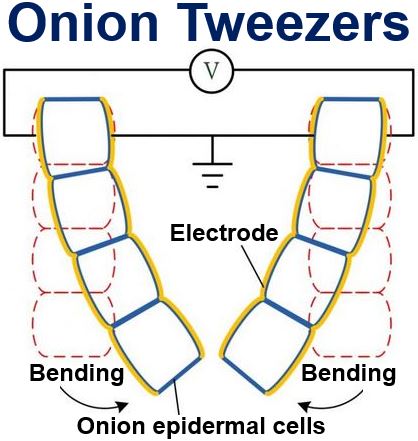Gold plated onions have been used to make artificial muscles that can bend or stretch when an electrical current is discharged, just like normal muscles do, researchers from the National Taiwan University reported today.
Unlike previous attempts at making artificial muscles, this onion one has excellent suppleness, contraction and stretchability, depending on the driving voltage applied, the scientists explained in the academic journal Applied Physics Letter.
Co-lead researcher Professor Wen-Pin Shih said:
“The initial goal was to develop an engineered microstructure in artificial muscles for increasing the actuation deformation [the amount the muscle can bend or stretch when triggered].”

The researchers managed to pick up a cotton ball with the onion tweezers. (Image: aip.org)
“One day, we found that the onion’s cell structure and its dimensions were similar to what we had been making.”
The fragile skin which lies just beneath the onion’s surface, the epidermis, is a very thin, translucent layer of blocky cells that are arranged in a closely-packed lattice.
Artificial muscle that stretches/contracts while bending
Prof. Shih and colleagues wondered whether onion epidermal cells might be good candidates for the challenging task of creating a more versatile muscle that could stretch or contract while bending.
So far, the researchers explained, artificial muscles have managed to either bend or contract, but not at the same time.
Prof. Shih and team treated the onion epidermal cells with acid to remove hemicellulose, a protein that makes cell walls rigid. They then coated both sides of the onion layer with gold.
When they applied an electric current through the gold electrodes, the onion cells bent and stretched, much like our muscles do.
Prof. Shih said:
“We intentionally made the top and bottom electrodes a different thickness so that the cell stiffness becomes asymmetric from top to bottom.”
The asymmetry gave the scientists control over the muscle’s response: a low voltage made them expand and flex downwards, toward the thicker bottom layer, while a high voltage made the cells contract and flex upwards, towards the thinner top layer.
Prof. Shih said:
“We found that the single-layer lattice structure can generate unique actuation modes that engineered artificial muscle has never achieved before.”
To demonstrate the utility of their device, the scientists combined two onion muscles into a pair of tweezers, which they used to pick up a ball of cotton.
They hope to be able to increase the lifting power of their artificial muscles. “Our next step is to reduce the driving voltage and the actuating force,” Shih explained.
Citation: “Onion artificial muscles,” Chien-Chun Chen, Wen-Pin Shih, Pei-Zen Chang, Hsi-Mei Lai, Shing-Yun Chang, Pin-Chun Huang, and Huai-An Jeng. Applied Physics Letter. DIO: 10.1063/1.4917498. Published 5 May, 2015.

